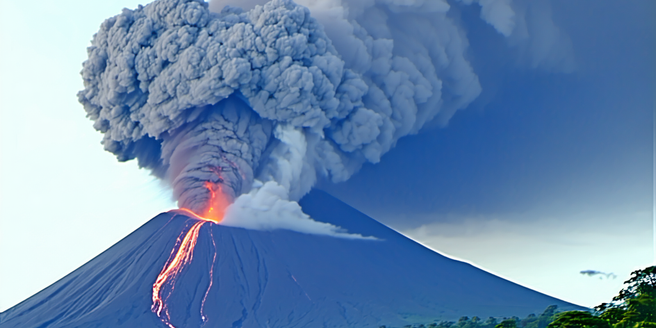
Understanding Volcanic Eruptions and Atmospheric Chemistry
Volcanic eruptions are dynamic geological events that release vast amounts of gases and particles into the atmosphere, significantly impacting atmospheric chemistry. The ejection of materials such as ash, water vapor, carbon dioxide, and volatile sulfur compounds into the stratosphere can alter atmospheric dynamics. The cooling effects and chemical transformations induced by these emissions can lead to short-term climate variability. Exploring volcanic eruptions offers insights into the natural processes affecting atmospheric composition and the synergistic interactions between volcanic products and climate. Understanding these processes is crucial for modeling climate impacts and improving predictive capabilities. Recognizing how volcanic activities interact with atmospheric chemistry helps scientists assess potential future scenarios and their implications for ecosystems and human populations. Thus, the study of volcanic eruptions extends beyond geology, serving as a vital intersection of earth sciences.
The Role of Volcanic Ash in Climate Change
Volcanic ash plays a crucial role in influencing climate change, primarily through its ability to reflect sunlight away from the Earth’s surface. When volcanic ash and aerosols are ejected into the atmosphere, they can lead to short-term cooling by blocking solar radiation. This can result in temporary decreases in global temperatures, a phenomenon known as volcanic winter. Over time, the settling of ash particles can influence atmospheric conditions and even initiate changes in weather patterns. Additionally, volcanic ash contributes nutrients to ecosystems, affecting the carbon cycle and further impacting climate. Understanding the complex interactions between volcanic ash and the atmosphere is vital for predicting their role in climate dynamics. These transient but significant changes highlight the importance of continuous research in tracking volcanic influences on climate systems.
Sulfur Dioxide Emissions and Global Cooling Effects
Sulfur dioxide (SO2) emissions from volcanic eruptions significantly contribute to global cooling effects. When released into the atmosphere, SO2 undergoes chemical reactions to form sulfate aerosols. These tiny particles efficiently scatter and reflect sunlight back into space, resulting in a temporary cooling of the Earth’s surface. Such cooling events have been observed following major eruptions, altering global temperatures and weather patterns. The 1991 eruption of Mount Pinatubo is a prime example, where a marked drop in global temperatures was recorded. The climatic influence of sulfur dioxide is a critical factor in understanding the broader implications of volcanic activity on global climate systems. The interactions involved prompt continued research into mitigating adverse effects and improving climate models impacted by these natural emissions.
Long-term Atmospheric Changes Post-Eruption
In the aftermath of a volcanic eruption, long-term atmospheric changes can occur, influencing global climate dynamics for years. Although the immediate cooling effects from aerosols like sulfur dioxide are more noticeable, long-lasting changes involve alterations in atmospheric circulation and cloud formation. The introduction of volcanic particulates and greenhouse gases into the atmosphere can trigger shifts in climate patterns such as the disruption of monsoons and jet streams. Over time, this can lead to changes in precipitation patterns and global temperatures. Exploring these extended impacts enhances the understanding of both historical climatology and future climate projections. Continuous monitoring and research are essential to comprehending the cumulative effects of these eruptions on Earth’s climate systems, emphasizing the importance of volcanic studies in forecasting long-term environmental changes.
Case Studies: Major Historical Volcanic Eruptions
Studying major historical volcanic eruptions provides valuable insights into their atmospheric impact and subsequent global effects. Events such as the 1815 eruption of Mount Tambora and the 1883 Krakatoa eruption offer critical data on climate shifts and cooling phases. Both eruptions injected massive quantities of aerosols into the atmosphere, substantially altering global temperatures and causing widespread climatic changes known as volcanic winters. These case studies highlight the intricate connections between volcanic activities and atmospheric sciences, revealing the extent to which eruptions can influence weather, agriculture, and human societies. By examining historical data, scientists gain a clearer understanding of potential future impacts, enhancing predictive models for volcanic activity. These insights underscore the need for preparedness and adaptation strategies in the face of potential future eruptions.
Mitigation and Preparedness for Volcanic Atmospheric Impact
Mitigating and preparing for the atmospheric impact of volcanic eruptions involves comprehensive scientific understanding and strategic planning. Early detection systems and real-time monitoring technologies play pivotal roles in predicting eruption impacts and mitigating risks. Understanding the composition of volcanic emissions and their atmospheric interactions is essential for developing effective response strategies. Collaborative efforts between scientists, governments, and international organizations are crucial for establishing robust preparedness plans. This includes crafting policies for emission controls, public awareness programs, and infrastructure resilience to withstand volcanic impacts. Enhancing predictive models and communication systems further enables regions to better prepare for the potential climatic and societal consequences of eruptions. These multifaceted approaches ensure communities are equipped to handle the challenges posed by future volcanic activities.
